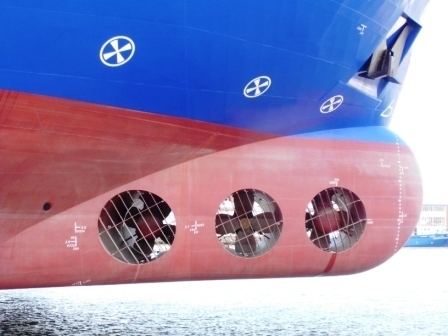 | ||
A bow thruster or stern thruster is a transversal propulsion device built into, or mounted to, either the bow or stern, of a ship or boat, to make it more maneuverable. Bow thrusters make docking easier, since they allow the captain to turn the vessel to port or starboard side, without using the main propulsion mechanism which requires some forward motion for turning; indeed, the effectiveness of a thruster is curtailed by any forward motion due to the Coandă effect. A stern thruster is of the same principle, fitted at the stern. Large ships might have multiple bow thrusters and stern thrusters.
Contents
Tunnel thrusters
Large vessels usually have one or more tunnel thrusters built into the bow, below the waterline. An impeller in the tunnel can create thrust in either direction which makes the ship turn. Most tunnel thrusters are driven by electric motors, but some are hydraulically powered. These bow thrusters, also known as tunnel thrusters, may allow the ship to dock without the assistance of tugboats, saving the costs of such service. Ships equipped with tunnel thrusters typically have a sign marked above the waterline over each thruster on both sides, as a big cross in a red circle: (x).
Tunnel thrusters increase the vessel's resistance to forward motion through the water, but this can be mitigated through proper fairing aft of the tunnel aperture (see below photo). Ship operators should take care to prevent fouling of the tunnel and impeller, either through use of a protective grate or by cleaning. During vessel design, it is important to determine whether tunnel emergence above the water surface is commonplace in heavy seas. Tunnel emergence hurts thruster performance, and may damage the thruster and the hull around it.
Waterjet bow thrusters
A waterjet thruster is a special type of bow thruster that utilizes a pumping device instead of a conventional propeller. The water is discharged through specially designed nozzles which increase the velocity of the exiting jet. Waterjets generally have the advantage of smaller hull penetrations for an equivalent size thruster. Additionally, the higher exit velocity of the discharged water increases the relative efficiency as speeds of advance, or currents, increase, as compared to standard tunnel thrusters. Some waterjet bow thrusters can be configured to provide forward and aft auxiliary propulsion, or even full 360 degree thrust.
